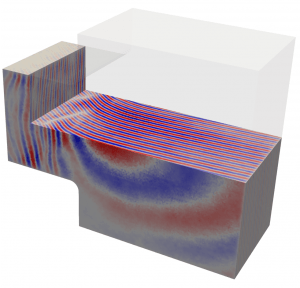PhD Defense: Willca VILLAFANA – “Numerical Particle-In-Cell studies of Hall thrusters using unstructured grids. “
Thursday 21 October 2021 at 16h00
Phd Thesis Jean-Claude ANDRE room Cerfacs

Abstract :
In a few decades, space has become a crucial part of our modern society. With the imminent deployment of mega satellite constellations, their number will increase dramatically. These future satellites will be mainly equipped with electric propulsion systems, and in particular Hall thrusters.
However, the processes governing the plasma physics within Hall thrusters remain poorly understood, which forces manufacturers to carry out costly and laborious experimental cam- paigns to certify the finished product.
To overcome this difficulty, numerical simulations are essential. They can be based on a Particle-In-Cell (PIC) method, well adapted to the physics of this type of plasma. Indeed, these plasmas present kinetic effects that cannot be accurately described by fluid methods. Due to the cost of PIC simulations and the complex phenomena involved, existing codes in the literature remain limited to academic configurations based on structured meshes. In an effort to overcome these challenges, the AVIP PIC code is developed at CERFACS as a predictive tool capable of modeling industrial configurations. To do this, AVIP PIC works with unstructured meshes, which no other code in the community can currently do. This innovation comes at the cost of a considerable complexity of the code and a substantial optimization work was first done in previous work.
Because of its innovative character, the first objective of this thesis was to systematically validate AVIP PIC. Thus, AVIP PIC was first used to participate successfully in an international benchmark on a 2D configuration in the axial-azimuthal plane. During this work, all groups obtained close results with 5% difference at most on the main plasma parameters profiles. An azimuthal plasma oscillation, the electron drift instability, was also observed by all participants with extremely similar characteristics. This instability due to kinetic effects, most probably plays a fundamental role in the anomalous transport of electrons within the engine. Based on this first success, we then used this case to explore and parameterize an active particle control algorithm. By preventing the number of particles from increasing too much, this tool reduces the computational cost and will be very useful in future simulations. Still in the perspective of code validation, we then studied a simplified 2D configuration in the radial- azimuthal plane of the engine. Indeed, taking into account the presence of the walls can considerably modify the simulated physics of the engine. In particular, we have highlighted a radial-azimuthal instability, also called modified two-stream instability, which is coupled to the electron drift instability mentioned above. A benchmark work, conducted by CERFACS with six international groups, confirmed this result with an excellent agreement, despite the great diversity of the codes involved.
Capitalizing on our experience in 2D, we then developed a 3D simulation based on the same geometrical elements and plasma conditions than in the two previous cases. During this study the 3D electron drift instability was identified as well as a possible signature of the radial- azimuth instability. The comparison with the previous 2D configurations seems to show that the 2D simulations tend to create a hotter and denser plasma, which affects the oscillatory phenomena. The general structure of the plasma remains nevertheless similar. Finally tools for the analysis of the code performance have been developed which will prove to be valuable for the development of more advanced 3D configurations.
Jury :
| Miles TURNER | Professor – NCPST/DCU | Referee |
| Thierry MAGIN | Professor – VKI | Referee |
| Anne BOURDON | Professor – CNRS/LPP | Member |
| Kentaro HARA | Professor – Université de Stanford | Member |
| Gwenael FUBIANI | Researcher – CNRS/LAPLACE | Member |
| Benjamin LAURENT | Research Engineer – SAE | Invited member |
| Bénédicte CUENOT | Senior researcher – CERFACS | Advisor |
| Olivier VERMOREL | Senior researcher – CERFACS | Co-advisor |
No content defined in the sidebar.

